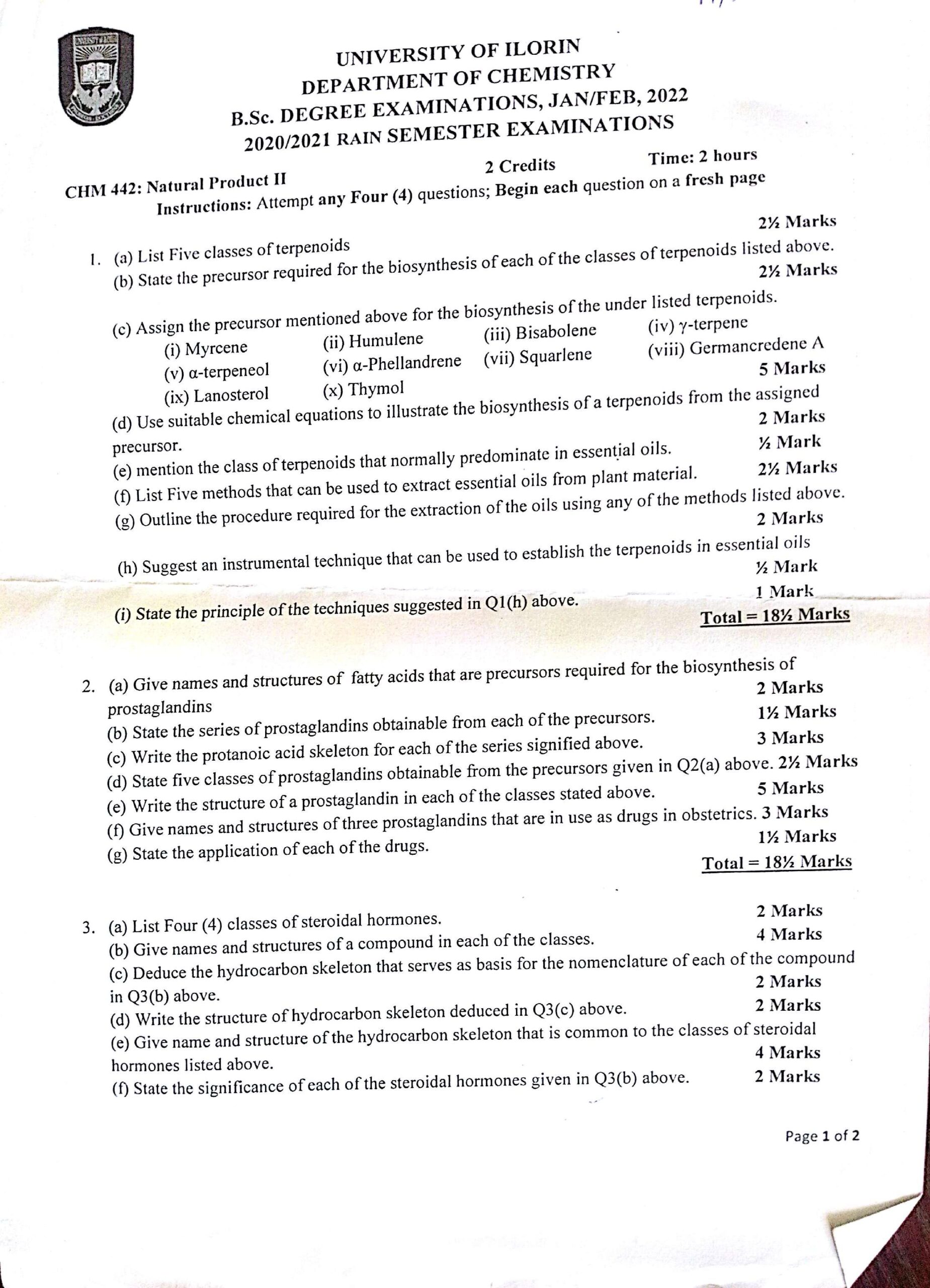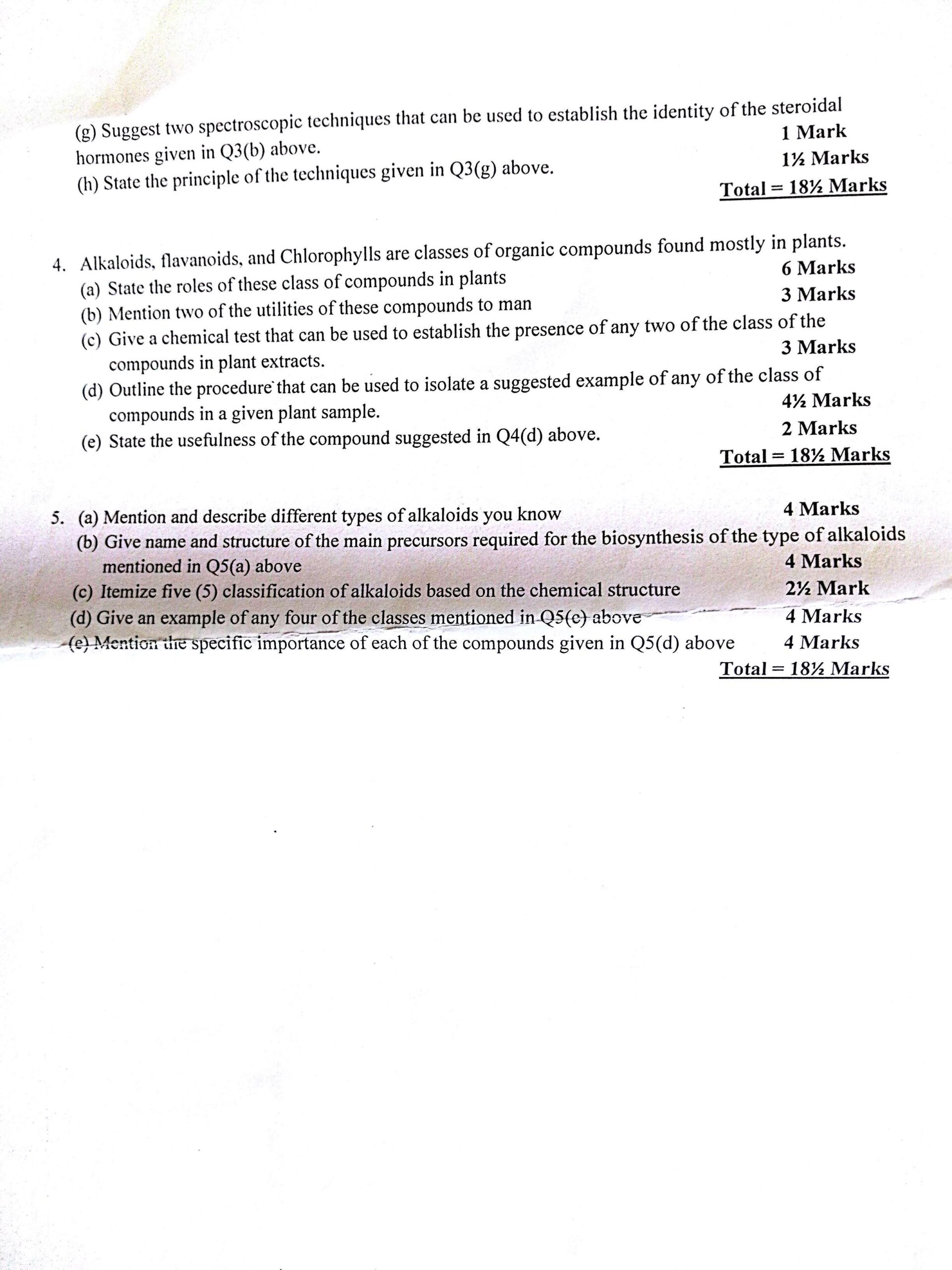COURSE TITLE: Natural Product II
COURSE CODE: CHM 442
DURATION: 2 Hours
Instructions
Attempt any Four (4) questions; Begin each question on a fresh page
Question 1a: List Five classes of terpenoids 2 1⁄2 Marks
Question 1b: State the precursor required for the biosynthesis of each of the classes of terpenoids listed above. 2 1⁄2 Marks
Question 1c: Assign the precursor mentioned above for the biosynthesis of the under listed terpenoids. (i) Myrcene (ii) Humulene (iii) Bisabolene (iv) y-terpene (v) a-terpeneol (vi) a-Phellandrene (vii) Squarlene (viii) Germancredene A 5 Marks (ix) Lanosterol (x) Thymol 5 Marks
Question 1d: Use suitable chemical equations to illustrate the biosynthesis of a terpenoids from the assigned precursor. 2 Marks
Question 1e: mention the class of terpenoids that normally predominate in essential oils. 1⁄2 Mark
Question 1f: List Five methods that can be used to extract essential oils from plant material. 2 1⁄2 Marks
Question 1g: Outline the procedure required for the extraction of the oils using any of the methods listed above. 2 Marks
Question 1h: Suggest an instrumental technique that can be used to establish the terpenoids in essential oils 1⁄2 Marks
Question 1i: State the principle of the techniques suggested in Q1(h) above. 1 Mark Total = 18 1⁄2 Marks
Question 2a: Give names and structures of fatty acids that are precursors required for the biosynthesis of prostaglandins 2 Marks
Question 2b: State the series of prostaglandins obtainable from each of the precursors.
Question 2c: (c) Write the protanoic acid skeleton for each of the series signified above.
Question 2d: (d) State five classes of prostaglandins obtainable from the precursors given in Q2(a) above.
Question 2e: Write the structure of a prostaglandin in each of the classes stated above.
Question 2f: Give names and structures of three prostaglandins that are in use as drugs in obstetrics.
Question 2g: State the application of each of the drugs.
Question 3a: List Four (4) classes of steroidal hormones.
Question 3b: Give names and structures of a compound in each of the classes.
Question 3c: Deduce the hydrocarbon skeleton that serves as basis for the nomenclature of each of the compound in Q3(b) above.
Question 3d: Write the structure of hydrocarbon skeleton deduced in Q3(c) above.
Question 3e: Give name and structure of the hydrocarbon skeleton that is common to the classes of steroidal hormones listed above.
Question 3f: State the significance of each of the steroidal hormones given in Q3(b) above.
Question 3g: Suggest two spectroscopic techniques that can be used to establish the identity of the steroidal hormones given in Q3(b) above.
Question 3h: State the principle of the techniques given in Q3(g) above.
Question 4a: Alkaloids, flavanoids, and Chlorophylls are classes of organic compounds found mostly in plants. (a) State the roles of these class of compounds in plants
Question 4b: Mention two of the utilities of these compounds to man
Question 4c: Give a chemical test that can be used to establish the presence of any two of the class of the compounds in plant extracts.
Question 4e: Outline the procedure that can be used to isolate a suggested example of any of the class of compounds in a given plant sample.
Question 4e: State the usefulness of the compound suggested in Q4(d) above.
Question 5a: Mention and describe different types of alkaloids you know
Question 5b: Give name and structure of the main precursors required for the biosynthesis of the type of alkaloids mentioned in Q5(a) above
Question 5c: Itemize five (5) classification of alkaloids based on the chemical structure
Question 5d: Give an example of any four of the classes mentioned in Q5(e) above
Question 5e: Mention the specific importance of each of the compounds given in Q5(d) above
Answers
Answer 1a:
Five classes of terpenoids:
Five classes of terpenoids:
- Monoterpenoids (C10)
- Sesquiterpenoids (C15)
- Diterpenoids (C20)
- Triterpenoids (C30)
- Tetraterpenoids (C40)
Answer 1b:
Precursors for biosynthesis:
Precursors for biosynthesis:
- Monoterpenoids: Geranyl pyrophosphate (GPP)
- Sesquiterpenoids: Farnesyl pyrophosphate (FPP)
- Diterpenoids: Geranylgeranyl pyrophosphate (GGPP)
- Triterpenoids: Squalene (from 2 FPP units)
- Tetraterpenoids: Phytoene (from 2 GGPP units)
Answer 1c:
Assign precursors to terpenoids:
Assign precursors to terpenoids:
- Myrcene: GPP
- Humulene: FPP
- Bisabolene: FPP
- γ-Terpinene: GPP
- α-Terpineol: GPP
- α-Phellandrene: GPP
- Squalene: 2 FPP
- Germacrene A: FPP
- Lanosterol: Squalene
- Thymol: GPP
Answer 1d:
(d) Biosynthesis example (Myrcene from GPP): GPP → Myrcene + PPi Equation: GPP (C10) undergoes elimination of pyrophosphate to form the monoterpene Myrcene.
(d) Biosynthesis example (Myrcene from GPP): GPP → Myrcene + PPi Equation: GPP (C10) undergoes elimination of pyrophosphate to form the monoterpene Myrcene.
Answer 1e:
(e) Class predominant in essential oils: Monoterpenoids and sesquiterpenoids.
(e) Class predominant in essential oils: Monoterpenoids and sesquiterpenoids.
Answer 1f:
(f) Extraction methods:
(f) Extraction methods:
- Steam distillation
- Solvent extraction
- Cold pressing (expression)
- Supercritical CO₂ extraction
- Enfleurage
Answer 1g:
(g) Procedure for steam distillation:
(g) Procedure for steam distillation:
- Heat plant material with water to release volatile oils.
- Collect vapor, condense into a mixture of oil and water.
- Separate oil via decantation or centrifugation.
Answer 1h:
(h) Instrumental technique: Gas Chromatography-Mass Spectrometry (GC-MS).
(h) Instrumental technique: Gas Chromatography-Mass Spectrometry (GC-MS).
Answer 1i:
(i) Principle of GC-MS: GC separates compounds based on volatility and column interaction; MS identifies them via mass-to-charge ratio.
(i) Principle of GC-MS: GC separates compounds based on volatility and column interaction; MS identifies them via mass-to-charge ratio.
Answer 2a:
Question 2: Prostaglandins (a) Precursors:
Question 2: Prostaglandins (a) Precursors:
- Arachidonic acid (C20:4 ω-6): Structure: 20 carbons, 4 double bonds at positions 5,8,11,14.
- Dihomo-γ-linolenic acid (DGLA) (C20:3 ω-6): Structure: 20 carbons, 3 double bonds at positions 8,11,14.
Answer 2b:
(b) Prostaglandin series:
(b) Prostaglandin series:
- Arachidonic acid → Series 2 (e.g., PGE₂)
- DGLA → Series 1 (e.g., PGE₁)
Answer 2c:
(c) Prostanoid acid skeleton: Cyclopentane ring with two side chains (carboxylic acid at C1, hydroxyl at C11).
(c) Prostanoid acid skeleton: Cyclopentane ring with two side chains (carboxylic acid at C1, hydroxyl at C11).
Answer 2d:
(d) Classes of prostaglandins:
(d) Classes of prostaglandins:
- PGE (keto group at C9)
- PGF (hydroxyl groups at C9 and C11)
- PGD (keto group at C9, hydroxyl at C11)
- PGA (cyclopentenone ring)
- PGB (conjugated diene in ring)
Answer 2e:
(e) Example structures:
(e) Example structures:
- PGE₂: Cyclopentane with keto (C9) and hydroxyl (C11).
- PGF₂α: Two hydroxyl groups (C9 and C11).
Answer 2f:
(f) Prostaglandins in obstetrics:
(f) Prostaglandins in obstetrics:
- Dinoprostone (PGE₂): Induces labor.
- Carboprost (15-methyl PGF₂α): Treats postpartum hemorrhage.
- Misoprostol (PGE₁ analog): Cervical ripening.
Answer 2g:
(g) Applications:
(g) Applications:
- Dinoprostone: Labor induction.
- Carboprost: Controls bleeding.
- Misoprostol: Medical abortion.
Answer 3a:
(a) Classes Steroidal Hormones:
(a) Classes Steroidal Hormones:
- Glucocorticoids
- Mineralocorticoids
- Androgens
- Estrogens
- Progestogens
Answer 3b:
(b) Examples Steroidal Hormones:
(b) Examples Steroidal Hormones:
- Cortisol (glucocorticoid): 17-hydroxy, 11β-hydroxy, 3-keto.
- Aldosterone (mineralocorticoid): 11β,21-dihydroxy, 18-aldehyde.
- Testosterone (androgen): 17β-hydroxy, 4-en-3-one.
- Estradiol (estrogen): Aromatic A-ring, 17β-hydroxy.
- Progesterone (progestogen): 4-en-3,20-dione.
Answer 3c:
(c) Hydrocarbon skeleton: Cyclopentanoperhydrophenanthrene (four fused rings: 3 cyclohexane, 1 cyclopentane).
(c) Hydrocarbon skeleton: Cyclopentanoperhydrophenanthrene (four fused rings: 3 cyclohexane, 1 cyclopentane).
Answer 3d:
(d) Structure:
(d) Structure:
D C / \ B \ / A
(A, B, C = cyclohexane; D = cyclopentane)
Answer 3e:
(e) Common skeleton: Gonane (steroid nucleus).
(e) Common skeleton: Gonane (steroid nucleus).
Answer 3f:
(f) Significance:
(f) Significance:
- Cortisol: Anti-inflammatory, metabolism regulation.
- Aldosterone: Sodium retention.
- Testosterone: Male secondary sex characteristics.
- Estradiol: Female reproductive function.
- Progesterone: Prepares uterus for pregnancy.
Answer 3g:
(g) Spectroscopic techniques:
(g) Spectroscopic techniques:
- Nuclear Magnetic Resonance (NMR)
- Infrared (IR) Spectroscopy
Answer 3h:
(h) Principles:
(h) Principles:
- NMR: Detects nuclear spin transitions in a magnetic field.
- IR: Measures vibrational energy transitions in bonds.
Answer 4a:
Question 4: Alkaloids, Flavonoids, Chlorophyll (a) Roles in plants:
Question 4: Alkaloids, Flavonoids, Chlorophyll (a) Roles in plants:
- Alkaloids: Defense against herbivores.
- Flavonoids: UV protection, pigmentation.
- Chlorophyll: Light absorption for photosynthesis.
Answer 4b:
(b) Utilities to humans:
(b) Utilities to humans:
- Alkaloids: Medicinal drugs (e.g., morphine).
- Flavonoids: Antioxidants in diet.
Answer 4c:
(c) Chemical tests:
(c) Chemical tests:
- Alkaloids: Dragendorff’s reagent → orange precipitate.
- Flavonoids: Shinoda test (Mg + HCl → red color).
Answer 4e:
(d) Isolation procedure (Alkaloids):
(d) Isolation procedure (Alkaloids):
- Grind plant material.
- Acidify with dilute HCl to extract alkaloids.
- Filter and basify with NH₃.
- Extract with chloroform.
- Evaporate to isolate alkaloids.
Answer 4e:
(e) Usefulness: Example: Quinine (antimalarial).
(e) Usefulness: Example: Quinine (antimalarial).
Answer 5a:
(a) Types:
(a) Types:
- True alkaloids (heterocyclic N, e.g., morphine).
- Protoalkaloids (non-heterocyclic N, e.g., ephedrine).
- Pseudoalkaloids (derived from terpenes/purines, e.g., caffeine).
Answer 5b:
Question 5: Alkaloids (b) Precursors:
Question 5: Alkaloids (b) Precursors:
- True: Tryptophan (indole alkaloids).
- Proto: Phenylalanine (ephedrine).
- Pseudo: Xanthosine (caffeine).
Answer 5c:
(c) Classification by structure:
(c) Classification by structure:
- Indole (e.g., vinblastine)
- Isoquinoline (e.g., morphine)
- Tropane (e.g., atropine)
- Pyrrolidine (e.g., nicotine)
- Quinoline (e.g., quinine)
Answer 5d:
(d) Examples:
(d) Examples:
- Indole: Vinblastine (anticancer).
- Isoquinoline: Morphine (analgesic).
- Tropane: Atropine (pupil dilation).
- Quinoline: Quinine (antimalarial).
Answer 5e:
(e) Importance:
(e) Importance:
- Vinblastine: Treats lymphoma.
- Morphine: Pain relief.
- Atropine: Antidote for nerve agents.
- Quinine: Malaria treatment.
Note: Structures are implied here; in the exam, draw chemical structures where required.



